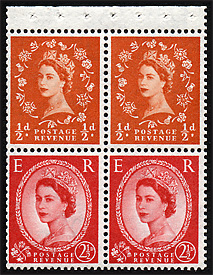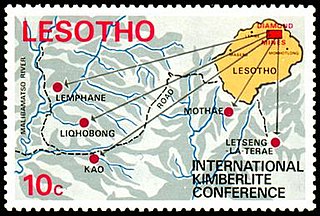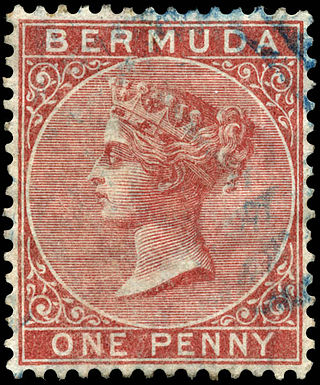
This is a survey of the postage stamps and postal history of Saint Helena.

This is a survey of the postage stamps and postal history of Saint Helena.

The first stamp of St Helena was issued on 1 January 1856. [1] It was a 6d blue imperforate stamp portraying Queen Victoria. From 1863 to 1880, this stamp was issued in various colours, perforated and overprinted for each value from 1d to 5s. This design continued to be used until 1884, when a new set of Victorian key types was issued for the colony.
The Victorian key types were replaced by a short-lived set of two King Edward VII key types in 1902. In 1903, a new pictorial definitive set of six values was issued. Three stamps showed King Edward and the Government House, and three others showed the King and the Wharf. In 1908, a set of four key types was issued. The values were additional values which were not included in the 1903 pictorial definitive (2½d, 4d, 6d and 10s).
The 1912-1916 King George V definitives were similar to the 1903 definitive, the only difference being the King's profile. However this time there were ten values in the set, ranging from ½d to 3s. Between 1912 and 1913 4d and 6d stamps (not included in the pictorial set) were issued in the form of a key type.

Between 1922 and 1937, a new definitive was issued. Designed by the St Helena-born Postmaster Thomas R. Bruce, it was similar to the 1912-16 pictorials, but instead of the Government House or the Wharf, these stamps showed the badge of St. Helena - a three-masted sailing ship near two large rocks. These values ranged from ½d to £1, and there are many varieties, such as the broken mainmast, the torn flag, and the cleft rock. In 1934, St. Helena's first commemorative set was issued. This was a set of 10 values up to 10s commemorating the centenary of British colonisation (1834-1934). In 1935, the Crown Agents omnibus issue commemorating the Silver Jubilee of King George V was issued.
The first King George VI set was that of the 1937 Coronation. Between 1938 and 1949, a new definitive was issued portraying King George VI and the badge of the Colony. However, the design was totally different from the 1922 badge set. All the commemorative sets issued in this reign were CA omnibus issues:

The first Queen Elizabeth issue was for the 1953 Coronation, followed by a pictorial definitive issued 1 month later. Issues were mainly commemorative or omnibus. On 12 October 1961, four Tristan da Cunha stamps were overprinted "ST. HELENA/Tristan Relief" with a surcharge. Only 454 sets were sold, mainly to tourists from a visiting cruise liner. This set was withdrawn on 19 October and is the most expensive set of St. Helena. St. Helena issues commemorative stamps regularly and still takes part in Crown Agents omnibus issues.

The postal and philatelic history of Canada concerns postage of the territories which have formed Canada. Before Canadian confederation, the colonies of British Columbia and Vancouver Island, Prince Edward Island, Nova Scotia, New Brunswick and Newfoundland issued stamps in their own names. The postal history falls into four major periods: French control (1604–1763), British control (1763–1841), colonial government control (1841–1867), and Canada, since 1867.

A definitive stamp is a postage stamp that is part of the regular issue of a country's stamps, available for sale by the post office for an extended period of time and designed to serve the everyday postal needs of the country. The term is used in contrast to a "provisional stamp", one that is issued for a temporary period until regular stamps are available, or a "commemorative stamp", a stamp "issued to honor a person or mark a special event" available only for a limited time. Commonly, a definitive issue or series includes stamps in a range of denominations sufficient to cover current postal rates. An "issue" generally means a set that is put on sale all at the same time, while a "series" is spread out over several years, but the terms are not precise. Additional stamps in a series may be produced as needed by changes in postal rates; nevertheless some values may be permanently available, regardless of prevailing rates; examples include 1c or 1p and $1 or £1.

Postage stamps and postal history of Great Britain surveys postal history from the United Kingdom and the postage stamps issued by that country and its various historical territories until the present day.

This is a survey of the postage stamps and postal history of the Falkland Islands.
This is a survey of the postage stamps and postal history of Hong Kong.

The postal history of the Bahamas begins in the 18th century, with the first post office operating since 1733. The earliest known letters date from 1802. In 1804 a straight-line "BAHAMAS" handstamp came into use. The Royal Mail Line initiated a regular mail service in 1841, and from 1846 used a "Crown Paid" handstamp along with a dated postmark for New Providence.
Ascension Island is an island in the South Atlantic Ocean, part of the wider British overseas territory of Saint Helena, Ascension and Tristan da Cunha. Like other British Overseas Territories, it issues its own postage stamps, which provide a source of income for the island from sales to overseas collectors, as well as being used for domestic and international postage.

The postage stamps of Ireland are issued by the postal operator of the independent Irish state. Ireland was part of the United Kingdom of Great Britain and Ireland when the world's first postage stamps were issued in 1840. These stamps, and all subsequent British issues, were used throughout Ireland until the new Irish Government assumed power in 1922. Beginning on 17 February 1922, existing British stamps were overprinted with Irish text to provide some definitives until separate Irish issues became available within the new Irish Free State. Following the overprints, a regular series of definitive stamps was produced by the new Department of Posts and Telegraphs, using domestic designs. These definitives were issued on 6 December 1922, the day that the Irish Free State officially came into existence; the first was a 2d stamp, depicting a map of Ireland. Since then new images, and additional values as needed, have produced nine definitive series of different designs.

The postal history of Malta began in the early modern period, when pre-adhesive mail was delivered to foreign destinations by privately owned ships for a fee. The earliest known letter from Malta, sent during the rule of the Order of St John, is dated 1532. The first formal postal service on the islands was established by the Order in 1708, with the post office being located at the Casa del Commun Tesoro in Valletta. The first postal markings on mail appeared later on in the 18th century.

The Wildings were a series of definitive postage and revenue stamps featuring the Dorothy Wilding photographic portrait of Queen Elizabeth II that were in use between 1952 and 1971. The Wildings were the first and only British stamps to feature graphite lines on the back, and the first to feature phosphor bands on the face – both aids to automation. The stamps were also the first British pictorial high value stamps and the first to include regional emblems.

This is a survey of the postage stamps and postal history of Jamaica.

This is a survey of the postage stamps and postal history of Gibraltar.
Belize started as the colony of British Honduras, formally established in the 17th century but disputed through the 18th century.

This is a survey of the postage stamps and postal history of Lesotho, formerly known as Basutoland.

This is a survey of the postage stamps and postal history of Tristan da Cunha.

This is a survey of the postage stamps and postal history of Sierra Leone.

Bermuda, a group of islands in the North Atlantic Ocean, was previously uninhabited when the British established a settlement in 1612.
The Foreign and Commonwealth Office Collection was formed by instruction from the Secretary of State for the Colonies on 23 April 1890 to all territories under his authority. The intention was to have a record of all Colonial Postage and revenue stamps, postcards, embossed envelopes and newspaper wrappers. The collection contains single examples of the stamps in use at that time as well as some obsolete issues and single copies, usually from first printings, from 1890. Variations such as colour varieties and alternate watermarked papers are included.
The Saint Helena, Ascension and Tristan da Cunha Philatelic Society (SHATPS), founded 1976, is the only philatelic society specialising in the philately of the three Atlantic islands of St. Helena, Ascension Island and Tristan da Cunha.

The Melita issue is a series of dual-purpose postage and revenue stamps issued by the Crown Colony of Malta between 1922 and 1926, depicting the national personification Melita. They were commemorative stamps since they celebrated the islands' new status as a self-governing colony following a new constitution in 1921, but also a definitive issue intended for regular use over an extended period of time.